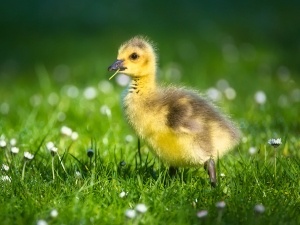
Waiting for baby ducks to hatch can be a stressful experience, these birds take time to hatch from their shells and there is no guarantee that they’ll be happy and healthy after they hatch.
A duckling hatching with an unabsorbed yolk is concerning. This article explores why this happens and what to do.
Table of Contents
Duckling hatched with unabsorbed yolk:
If your baby bird hatched, and doesn’t look like the rest, if the bird hatched with an unabsorbed yolk, then this may be why and what to do:
Why this happened:
Incorrect incubator settings
The conditions that your eggs were incubated in can affect how the bird comes out. The incubator temperature and humidity settings affect the eggs in a big way.
If the temperature of your incubator fluctuates while the eggs are incubating then the duckling may hatch too early.
If the duckling hatches too early then it won’t have the opportunity to absorb the yolk and the bird will hatch with the yolk outside of its body.
Assisted hatching:
Ducks take quite a while to hatch, these birds will internally pip and only externally pip around 12-24 hours later and then hatch 2-3 days after externally pipping.
If you’re used to hatching chicks you’ll know that this is about 3 times as long as it takes a chicken to hatch after it internally pips.
You may try to help the bird hatch but this may not be a good idea.
Ducklings need time to absorb the yolk sac, if you help the bird hatch too early, then you may rob the bird of the opportunity to absorb the yolk sac and the bird will come out with an unabsorbed yolk sack.
This may be what is going on with your bird.
What to do:
What to do about the yolk sac:
If the yolk sac is still attached to the duckling after the bird hatches then it would be best to leave the bird alone and not try to separate the yolk from the duck.
The bird will more than likely absorb the yolk if given enough time to do so. Give the bird time to do this.
Keep the yolk sac moist so the bird can absorb it. If the yolk sac is left to dry then it will fall off.
Feeding the bird:
If the bird doesn’t absorb all of the yolk sac then the bird will need to be fed earlier than normal.
Birds who absorb their yolk sacks will derive nutrients and will be sustained by the yolk sac for the first 24 hours of life. You can feed these birds 24 hours after hatching.
Birds who don’t absorb the yolk sac will have nothing to sustain them for the first 24 hours of life. If the bird doesn’t absorb all of its yolk sac then it will be very weak and you will need to feed the bird early on in its life.
Start off by feeding the bird some sugar water, this will help the bird perk up.
If the bird takes the sugar water, then you can move on to feeding the bird waterfowl starter crumbs or unmedicated chick crumbs.
Because the bird is so young and very weak you’d need to make this food as easily digestible as possible. Do this by grinding up the starter crumbs or unmedicated chick crumbs and softening them up by adding room temperature water to them.
Feeding your bird a multivitamin is also recommended if the bird doesn’t absorb the yolk sac.
Keep the bird warm:
A bird that hatched with an unabsorbed yolk will need to be kept warm, all ducklings need outside sources of warmth early on in life. You can use your own body heat to do this or you can create a brooder for them.
You can make a makeshift brooder out of a cardboard box, add a red heat lamp to the brooder to keep the bird warm.
This enclosure will work similarly to an intensive care unit, it should be a clean environment away from the other ducklings. Ducklings are messy, and allowing them to mix can cause an infection to develop in the premature bird.
Also, keep the enclosure clean, use paper towels at the bottom of the enclosure and change the towels when the bird soils them. You can also use a soft bedding like pine shavings.
You can alternatively choose to keep the bird close to your body and share some of your body heat with it. Clean the bird up, wrap a thin towel around it, and then cuddle the bird close to your body to keep it warm.
Sleeping arrangements:
Leave the bird in the enclosure overnight. Do not let the bird sleep with you as you may roll over and crush it.
Lay a light tea towel over the bird’s body as it sleeps to keep it warm throughout the night. This will give a similar effect to the bird sleeping under the mother’s wings at night.
The baby bird should be out of hot water after 5 days or a week.
If you enjoyed this article then you may also be interested in other duck related articles. Here are some articles that you may be interested in: Duck Eggs Not Pipping, Newly Hatched Duckling Problems, Weak Duckling, Lethargic Duckling,

